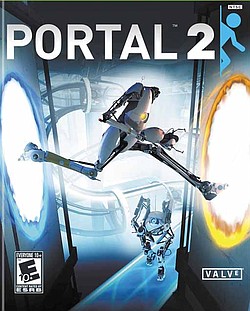VIDEO GAME REVIEW | Portal 2
VIDEO GAME REVIEW
Portal 2
Grade: A
Details: published by Valve, for the Xbox 360, PlayStation 3, $54.99; PC, Mac, $44.99
The Aperture Science Handheld Portal Device could change your life. Imagine a tool that lets you instantaneously cross vast distances by blowing holes through the time-space continuum. Put one hole in your office, one hole in your living room, and boom: No more endless commutes. No more pollution-spewing traffic jams. No more drive-time radio.
Unfortunately, the portal gun’s range, for now, is limited to the environs of Aperture Laboratories. And its inventors — along with every other human in the Aperture complex — appear to be dead.
That’s the dire situation at the beginning of “Portal 2.” And GLaDOS, the psychotic artificial intelligence you dismantled in the original “Portal,” is back in charge — and she isn’t happy.
The 2007 “Portal” was a delightful surprise. Initially packaged with four other games as “The Orange Box,” its cerebral puzzles proved a welcome change-of-pace from Valve’s usual bread-and-butter, the first-person shooter.
Each room in Aperture Laboratories is, essentially, a three-dimensional maze; you have to figure out how to use the portal gun and a handful of other gadgets to reach an inconveniently placed exit.
There’s also a batch of clever new toys to play with. Aerial Faith Plates fling your character across bottomless pits. Gels make the floor bouncy or slippery. Hard Light Bridges can be used to cross gaps or block turret fire.
The most important returning character is GLaDOS , whose once helpful demeanor has curdled into murderous sarcasm. (“We’ve both said a lot of things you’re going to regret,” she informs you early on.) But two new voices make equally memorable impressions. Wheatley, played by Stephen Merchant, is a chatty, nervous A.I. who’s eager to help you escape. Cave Johnson, performed by J.K. Simmons, is Aperture’s long-dead CEO, whose gung-ho encouragement devolves into fatalism.
The actors have created three of the most distinctive characters in video games — an amazing feat, considering they’re (mostly) disembodied voices. They are helped immeasurably by an often hilarious script by a team led by former game critic Erik Wolpaw.
It took me about nine hours to finish the single-player adventure — but a few of those hours consisted of simply staring at the screen, trying to conjure up a solution to a particularly thorny brain-teaser.
Unfortunately, if you can’t solve a puzzle you’re stuck. I found that some of the trickier solutions came to me if I stepped away for a while; it may also help to ask a friend to take a second look. And while you’ve got company, you can tackle an assortment of two-player, cooperative “Portal 2” puzzles. Each player commands one robot, and you have to work together to solve each maze. They’re easier than the solo campaign — but two robots with two portal guns make the action a bit more hectic.
There were some doubts that the “Portal” prototype could be stretched into a full-fledged (and full-priced) game, but Valve has delivered a sequel that builds upon the original while retaining its innovative spirit. In a market that’s drowning in lookalike first-person shooters, the thought-provoking “Portal 2” is a blast.
Lou Kesten, Associated Press
 43
43

